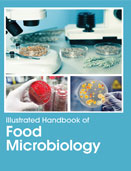Handbooks

In order to control food safety and quality from primary production to consumption, solid knowledge of food microbiology is necessary. It includes microorganisms that contaminate food, as well as those used in its production, for example to produce yoghurt, cheese, beer and wine. This handbook covers the three main aspects of the interaction between micro-organisms and food spoilage, foodborne illness and fermentation and the positive and negative features that result. It discusses the factors affecting the presence of micro-organisms in foods and their capacity to survive and grow.
Microbiology is important to food safety, production, processing, preservation, and storage. Food microbiology, the branch of biology, deals with the application of microorganisms in food contamination, spoilage and preservation. This includes microorganisms that contaminate food, as well as those used in its production; for example to produce yoghurt, cheese, beer and wine. Food microbes are the microbes that can be used in order to process and alter the unsafe product in consumable one. These food microbes can be live bacteria, yeasts or moulds. Food microbes carry out the fermentation process in food stuffs and helps to preserve perishable foods and to improve their nutritional and organoleptic qualities. Bacteria are the most important microorganisms to the food processor. Most are harmless, many are highly beneficial, some indicate the probable presence of filth, disease organisms, spoilage and a few cause disease. There are thousands of species of bacteria, but all are single-celled and fall into three basic shapes: spherical, straight rods, and spiral rods. Foods may be contaminated by each other and by pieces of equipment with which they come in contact. Air, dust, water, and ingredients may add their quota of contaminants. Whenever food is handled personally by human beings, there is always the possibility of addition of human pathogens. In the framework of this Text, a brief overview will be given about micro-organisms that play an important role in production, storage and consumption of foods. Their occurrence, characteristics used for identification, conditions of growth and eventual industrial use will be treated.
Illustrated Handbook of Food Microbiology is intended to provide a comprehensive coverage of different aspects of food preservation, food spoilage, food contamination, food hygiene regulations, food intoxication, food borne diseases, beneficial microorganisms in food, food poisoning, and food additives. Lost productivity resulting from illness caused by foodborne microorganisms is an enormous economic burden throughout the world. The study of food microbiology includes understanding not only the factors influencing the growth of microorganisms in food systems but also the means of controlling them.
Illustrated Handbook of Food Microbiology discusses the handling guidelines and accessing processes of food product in order to prevent and rescue them from all the unwanted and unhealthy factors. These practices and actions can minimize risk from potential hazards and will enhance the quality and productivity of food. The market analysis of food testing elaborates the market ratios by considering the growth factors to be associated with a food product such as growing demand for agro-chemicals, adoption of precision farming and protected agriculture, and increased farm expenditure. This enables a better understanding of market strategies for productivity of food microorganisms.